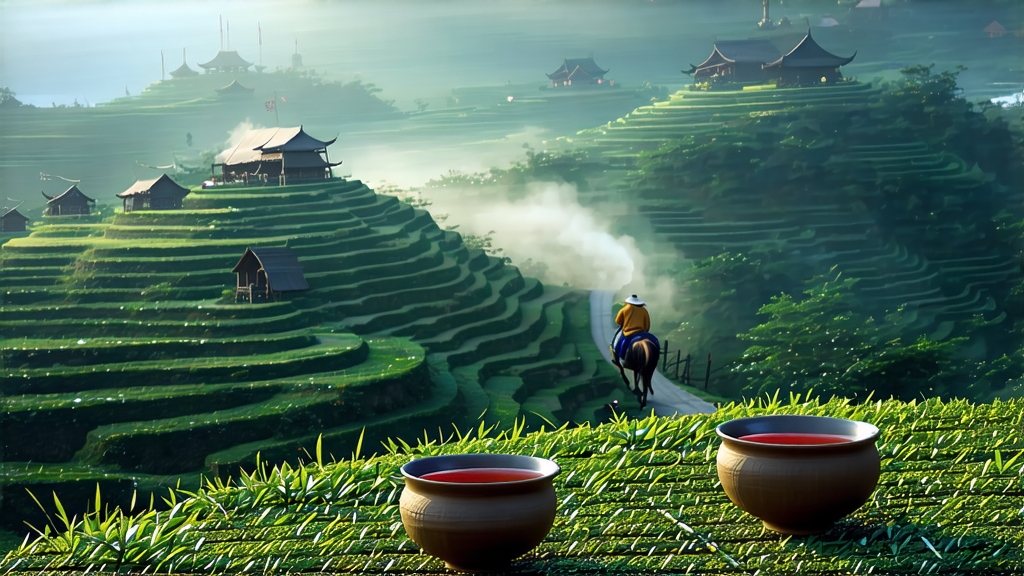
Tucked into the humid folds of southern China’s Guangxi Zhuang Autonomous Region, the small river town of Wuzhou has been whispering secrets to traders since the Ming dynasty. Among those secrets is Liubao cha, a dark tea whose leaves remember the jangle of horse bells on the old Spice Road and the salt-spray of the Pearl River delta. To international drinkers who equate “dark tea” solely with Yunnan’s pu-erh, Liubao offers a quieter, more maritime story—one of betel groves, river mist, and the subtle art of “wet-piling” that predates many better-known fermentation techniques.
Historical currents
Liubao’s documented history begins in the late Ming (early 1600s), when local growers along the Liubao tributary of the Xun River compressed their summer harvest into tight bamboo baskets and sent the tea downstream to Wuzhou’s port. From there, junks carried it to Guangzhou, where foreign merchants bought it as ballast for ships bound for Southeast Asia. In the humid holds, the tea continued to ferment, arriving in Kuala Lumpur or Jakarta with a musty-sweet fragrance that dockworkers nicknamed “the Chinese truffle.” By the Qing Qianlong era (1736–1795), Liubao was listed among the 24 tribute teas presented to the imperial court, praised for “warming the stomach and cutting grease.” When British tea magnates established iced-tea factories in Malaya during the 1920s, Liubao became the secret backbone of “black iced tea” because its earthy depth remained vivid even after chilling and dilution.
Micro-terroirs and leaf styles
Guangxi’s subtropical climate—year-round humidity, acidic red laterite soil, and frequent hill fog—creates a perfect incubator for large-leaf Camellia sinensis var. assamica. Within Liubao county, three micro-zones are now recognized:
- Liuxiang: highest elevation (600–800 m), slow growth, leaves rich in amino acids, yielding a honeyed finish.
- Tangping: mid-slope (300–500 m), mineral-rich spring water, leaves broader, liquor more resinous.
- Hechong: riverbank terraces, alluvial silt, fastest growing, pronounced betel-nut aroma.
Farmers pluck one bud plus three to four leaves in late April, when the monsoon begins. The extra mature leaves are essential; their thicker cell walls survive the forthcoming wet-piling without turning to compost.
Crafting darkness: the six acts
Unlike pu-erh’s sun-fixation, Liubao follows a unique “basket-fermentation” protocol that has changed little since the Jiaqing reign.
- Outdoor withering: leaves are spread on bamboo screens under morning hill fog for 4–6 h, losing about 15 % moisture while absorbing ambient microbes.
- Wok kill-green: 280 °C for 90 s, enough to denature polyphenol oxidase but preserve surface yeasts.
- Rolling & strip-breaking: a 30-min machine roll ruptures 60 % of cells, releasing catechins that will later polymerize into theaflavins and thearubigins.
- Sun-drying: leaves are scattered on reed mats for one full day until 70 % dry; UV triggers the first wave of non-enzymatic browning.
- Wet-piling (fa dui): the signature step. Leaves are sprayed with Liubao spring water (pH 6.2), heaped 60 cm deep inside bamboo-walled pits, and covered with jute sacks. Internal temperature climbs to 55 °C within 36 h; every 48 h the pile is turned, aerated, and re-sprayed. Over 12–18 days, a microbial consortium dominated by Aspergillus niger, Blastobotrys adeninivorans, and local Bacillus strains converts bitter catechins into mellow theabrownins and creates the characteristic “betel-nose” note—an earthy, camphor-like aroma reminiscent of areca nut.
- Basket compression & aging: the fermented leaf is steamed for 20 s, packed into 40 kg cylindrical bamboo baskets lined with wild banana leaf, then stored in rivers